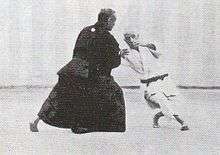Koshiki-no-kata
| Koshiki no Kata | |
|---|---|
|
Kanō and Yamashita performing Koshiki-no-kata | |
| Classification | Kata |
| Sub classification | Kodokan kata |
| Kodokan | Yes |
| Technique name | |
| Rōmaji | Koshiki-no-kata |
| Japanese | 古式の形 |
| English | Ancient Forms |
Koshiki no Kata (古式の形 Koshiki-no-kata, Form of the antique things) is a kata (a set of prearranged techniques) in Judo. It is also known as Kito-ryu no Kata. It consists of 21 techniques originally belonging to the Takenaka-ha [1] Kito School of jujutsu. Jigoro Kano revised the techniques and incorporated them into a kata in order to preserve the historical source of judo. The set of forms is antique and were intended for "Kumiuchi", the grappling of armored warriors in the feudal ages. As such, the kata is to be performed with both partners imagining that they are clad in armor.[2] The Koshiki-no-kata, together with Nage-no-kata, Katame-no-kata, Ju-no-kata, Kime-no-kata and Goshin-Jitsu, is recognised by the International Judo Federation (IJF.)[3] Although koshiki-no-kata is not often seen in the United States, it is still taught and practiced in Japan. Some striking demonstrations of it from the 1950s can be seen in the film "Classic Judo Kata," by Harold Sharp. If the description of the kata in that film is correct, it would be the only judo kata that involves attacking the cervical spine.
Techniques
- Omote (Front)
- Tai (Ready Posture)
- Yume-no-uchi (Dreaming)
- Ryokuhi (Strength Dodging)
- Mizu-guruma (Water Wheel)
- Mizu-nagare (Water Flow)
- Hikiotoshi (Draw Drop)
- Ko-daore (Log Fall)
- Uchikudaki (Smashing)
- Tani-otoshi (Valley Drop)
- Kuruma-daore (Wheel Throw)
- Shikoro-dori (Grabbing the Neckplates)
- Shikoro-gaeshi (Twisting the Neckplates)
- Yudachi (Shower)
- Taki-otoshi (Waterfall Drop)
- Ura (back)
- Mi-kudaki (Body Smashing)
- Kuruma-gaeshi (Wheel Throw)
- Mizu-iri (Water Plunge)
- Ryusetsu (Willow Snow)
- Sakaotoshi (Headlong Fall)
- Yukiore (Snowbreak)
- Iwa-nami (Wave on the Rocks)
Video of Koshiki-no-kata
- "Koshiki no kata performed by M° Yamashita" on YouTube
- "Miyake Koshiki no kata" on YouTube
- "Jigoro Kano Kito Ryu no Kata koshiki omote full version" on YouTube
References
- ↑ During a seminar held in 2007 in Solferino (IT) Alfredo Vismara (9th Dan) explains in his speech "Kito Ryu" the origin of the Koshiki-no-Kata and the difference between the one inherited from the Takenaka-ha Kito Ryu Ju-Jitsu by Kano Jigoro and the version endorsed by the Kodokan. Vismara speech (in Italian.) |publisher=AISE |accessdate=November 5, 2012
- ↑ "Koshiki No Kata". judoinfo.com. Retrieved June 19, 2012.
- ↑ "International Judo Federation rank requirements". Retrieved November 6, 2012.
